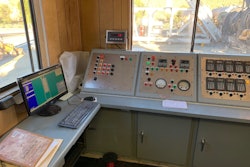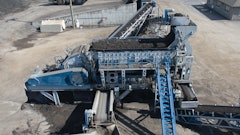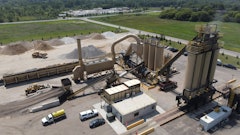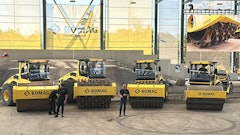
As a part of the services we offer at C.M. Consulting, we do a lot of plant ‘Troubleshooting’. Both on the phone and out in the field. The problem may be mix design compliance, air quality compliance, burner tuning, trunnion alignment or any of the myriad of other thing that go wrong at our asphalt plants on a daily basis.
Troubleshooting over the telephone has a number of pitfalls. You can’t look at the equipment and see obvious problems for one thing. If you could you might notice something that isn’t noticeable to the guy you are trying to help. Also, most asphalt plant operators tend to focus on symptoms of a problem not the cause. For instance, if the burner flame is unstable they rarely check the exhaust damper actuator is working. Or check the fuel pressure to see if they have good flow.
A prime example of this occurred in southeast a few years back. I had a call from a plant operator we’ve worked with before. His diesel burner wouldn’t light. I went through a checklist of things with him:
- Fuel Pressure - 35 pounds.
- Propane Bottle - Full & On
- Exhaust Fan - On & Damper Closed
- Burner Blower - On
- Burner Closed - Yes
- ‘Safe to Start’ Light - On
So I spent a day telling the kid how to check things like igniter and spark plug, and how to disassemble the burner fuel nozzle and clean it. But ‘No Joy’. Late in the day the owner called me and said “Get on a plane and get down here!”
After flying all night from Oregon, I rented a car and drove out to the plant. The owner met me and we walked over to look at his burner. We stood there talking for a moment before I noticed that the fuel pressure gauge read 35#. This was quite interesting since I couldn’t hear anything running at the plant. I went over and found the fuel pump. It was turned off. So I went back to the burner and found the ‘fuel pressure’ safety switch. It was partially disassembled and wired around. Great!
I went into the control room, found the fuel pump starter, saw that its overloads were tripped, and pushed the re-set button. Then I started up everything and the burner lit right up. Had someone told me that the fuel pressure safety switch had been wired around I would have recognized the issue fairly early on. That switch is part of the ‘safe to start’ circuit. Unless the burner has fuel pressure, you can’t try to light it. That little bit of information would have saved this plant owner almost $4,000 in my fees and expenses, plus over a full day of ‘downtime’, which is by far the most expensive commodity at any asphalt plant.
At another plant a few years later I found myself again in a position of trying to trouble shoot a burner while not being in possession of all the facts.
Spring is a rainy time in the Pacific Northwest. After four days of constant rain the weather broke and a long term client of mine fired up his plant. After running a few hours they started having problems with the burner. It would light and work fine some of the time, however sometimes it wouldn’t light. The operator told me in real time over Facebook’s ‘Instant Messenger’ that he was having the most trouble when coming out of a ‘hot-stop’. That seemed odd to me because exactly nothing changes for a burner re-light.
The next day the problem continued. After several lengthy troubleshooting sessions fighting an intermittent problem the owner called me and asked me to “Get up there!” So I got up there.
The plant is only a 6 hour drive from my shops, so I got there early in the afternoon. We started in with all the normal trouble shooting routines and could not find any problems. We checked voltages to every connection, but nothing. Finally the operator mentioned that last winter they had replaced the main burner control cable and put it in an underground PVC conduit. Thinking maybe they had left a wire loose, I personally checked every single wire connection from the control house to the burner. Nothing. I even went as far as to ‘ring’ (check continuity through wires) all the wires from the burner control to the burner junction box. No problems.
At this point I had started to suspect the flame eye circuit because the fire would often light for ten seconds, then the controller would go to a ‘flame fail’ error. Now being the brilliant electrical genius that I am, I decided on a ‘Bubba-Fix.' I ran a regular household extension cord out to the burner and used it to replace the wires going to the ‘flame eyes’. I disconnected the existing ‘flame eye’ wires out in the burner J-Box. Still no Joy. She would light, then go out after a few seconds.
Then I had some inspiration. I disconnected the old ‘flame eye’ wires off the Honeywell RM-7898 burner controller and just used the extension cord. The burner ran perfectly. Why? The company needed to fill the silos for the next day’s operations so I set back and watched the drum spin for a few hours.
Next morning I was at the plant looking around and I noticed that the PVC conduit that they had used to run the burner cable in was broken at ground level. After all the rain they had been having, I mentioned to the plant operator that they need to address that because their conduit could fill up with water. He told me that he would fix it right away, because that could mess with their splice.
SPLICE? What splice? He then told me that they didn’t have a long enough piece of 16/16 tray cable to reach the burner so they spliced on twenty five feet. That splice was underground in the PVC conduit. So I asked what kind of splice they used. ‘butt connectors’ was the reply.
BUTT CONNECTORS? In a waterlogged PVC conduit? What could go wrong? So I pulled the soggy tray cable out of the conduit, cut the spliced part off and routed the cable to the control house above ground so that it was one piece. The water was ‘sinking’ the ‘flame eye’ voltage enough that the RM-7898 controller would shut down the burner. Not enough that I could see the fluctuations, but enough that the controller was doing its job and turning off the burner as it thought the flame failed. Needless to say, the burner has worked flawlessly since that day.
If you want to hook up on Facebook for real time troubleshooting or just to chat, you may find me at www.facebook.com/cliff.mansfield.3



















